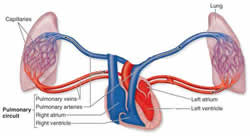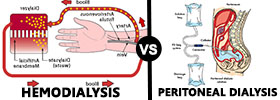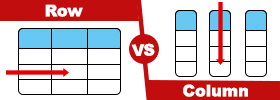Difference between Systemic Circulation and Pulmonary Circulation
Key Difference: Systemic Circulation is a part of the cardiovascular system which is responsible for carrying oxygenated blood away from the heart to the body, and return deoxygenated blood back to the heart. Pulmonary Circulation is a part of the cardiovascular system which is responsible for carrying de-oxygenated from the heart to the lungs and then back to the heart for it to transfer the oxygenated blood to the rest of the body.
The heart is an important muscle in the body and is located between the two lungs. The main purpose of the heart is to pump blood through the whole body. This function is performed with the help of Systemic Circulation and Pulmonary Circulation, which are responsible for the circulation of blood. The heart is made up of four chambers; two upper atria and lower two ventricles. The right side of the heart is responsible for dealing with the deoxygenate blood, while the left side deals with oxygenated blood. Systemic Circulation is the process of carrying oxygenated blood to the body, while the Pulmonary Circulation is the process of carrying oxy-gen depleted blood from the heart to the lungs. They play a major part in the process and functioning of the heart.

Systemic Circulation is a part of the cardiovascular system which is responsible for carrying oxygenated blood away from the heart to the body, and return deoxygenated blood back to the heart. The theory of circulation was first described by William Harvey. The oxygenated blood leaves through the left ventricle to the aorta, the body’s largest artery, by the aortic valve. The aorta is divided into arterioles which are further divided into capillaries. The blood is then transported to major arteries in the upper body before passing through the diaphragm, where it branches further into arteries which supply the lower parts of the body through the capillaries.
The oxygenated blood replaces the waste and carbon dioxide from cells with oxygen through diffusion and carries the waste to the capillaries which then once again merge into venules, which continue to merge into veins, and then the venae cavae: the lower inferior vena cava and the upper superior vena cava, through which the blood re-enters the heart at the right atrium. The heart itself receives oxygen and nutrients through a small "loop" of the systemic circulation.
During systemic circulation, the blood also passes through the kidneys, which filter as much waste from the blood as it can. This is known as renal circulation. The blood also passes through the small intestine during circulation. This is known as portal circulation. The blood from the small intestine is collected in the portal vein and is carried through the liver, which filters sugars and stores them for later use.
 Pulmonary Circulation is a part of the cardiovascular system which is responsible for carrying de-oxygenated from the heart to the lungs and then back to the heart for it to transfer the oxygenated blood to the rest of the body. The theory of pulmonary circulation was first described by an Arab physician named Ibn al-Nafis. The deoxygenated blood from the cells enters the heart from the right atrium. The blood then flows from the atrium by the contracting muscle through the tricuspid valve, a valve which opens only one way, to the right ventricle.
Pulmonary Circulation is a part of the cardiovascular system which is responsible for carrying de-oxygenated from the heart to the lungs and then back to the heart for it to transfer the oxygenated blood to the rest of the body. The theory of pulmonary circulation was first described by an Arab physician named Ibn al-Nafis. The deoxygenated blood from the cells enters the heart from the right atrium. The blood then flows from the atrium by the contracting muscle through the tricuspid valve, a valve which opens only one way, to the right ventricle.
Blood is then passed on to the lungs via the pulmonary artery, where it the carbon dioxide from the blood is replaced with oxygen through diffusion. The oxygenated blood is passed on to first to the left atrium of the heart by the pulmonary veins and then to the left ventricle for the systemic circulation to take place. The heartbeats that one hears is the opening and closing of the one-way valves that allow blood to flow from one ventricles to the other. This is an important process of pulmonary circulation.
Pulmonary circulation and systemic circulation go hand in hand and are jointly responsible for sending blood throughout the body. Pulmonary Circulation takes deoxygenated blood and converts it back to oxygenated blood, while systemic circulation takes the oxygenated blood to the cells and brings back the deoxygenated blood that is released by the cells in the body. Pulmonary Circulation deals solely with the lungs, while systemic circulation deals with the rest of the body.
|
|
Systemic Circulation |
Pulmonary Circulation |
|
Definition |
Systemic circulation is part of the cardiovascular system which helps carries oxygenated blood away from the heart to the body, and returns deoxygenated blood back to the heart. |
Pulmonary Circulation is the half portion of the cardiovascular system which helps carry oxygen-depleted blood away from the heart, to the lungs, and returns oxygenated blood back to the heart. |
|
Proposed by |
William Harvey |
Ibn al-Nafis |
|
Function |
To carry oxygenated blood to the body. |
Help carry oxygen-depleted blood to the lungs and return oxygenated blood to the heart. |
|
Course |
In systemic circulation, blood leaves through the left ventricle to the aorta, which is then sent to smaller arteries, arterioles, and finally capillaries. Waste and carbon in a cell is replaced by oxygen and the waste and carried away by the blood to venious capillaries, and then the venae cavae: the lower inferior vena cava and the upper superior vena cava, through which the blood re-enters the heart at the right atrium. |
In pulmonary circulation, de-oxygenated blood leaves the heart, goes to the lungs and then re-enters the heart; de-oxygenated blood leaves through the right ventricle through the pulmonary artery to the capillaries where carbon dioxide diffuses out of the blood cell into the alveoli, and oxygen diffuses out of the alveoli into the blood. Blood leaves the capillaries to the pulmonary vein to the heart, where it re-enters at the left atrium. |
|
Deals with which side of the heart |
Left side of the heart. |
Right side of the heart. |
Image Courtesy: becomehealthynow.com, mananatomy.com









Comments
kuda
Sun, 11/06/2016 - 22:14
Wow, so helpful
Emmanuel Mandipa
Sat, 03/14/2015 - 14:56
its cool!
shyni
Fri, 01/23/2015 - 19:34
very good
hritick
Sun, 08/24/2014 - 18:05
OK ,the answer are helpful
jeelan
Wed, 07/23/2014 - 15:10
This is verry interesting
khylefloresjames
Wed, 07/09/2014 - 17:18
In this article a different image should be uploaded this diagram is not clear
anoynomous
Sun, 06/08/2014 - 19:07
Add new comment